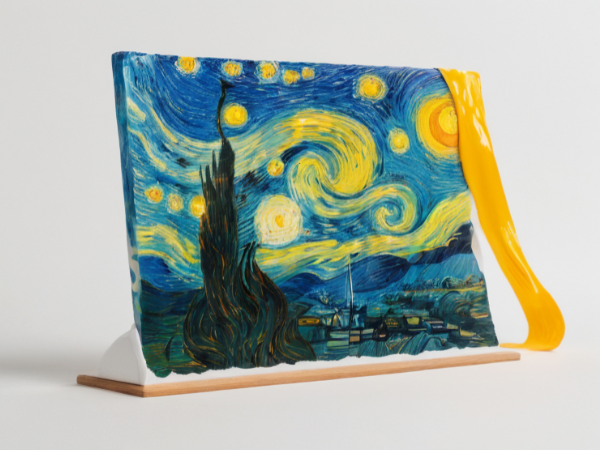Art history is filled with works that transcend their canvases, becoming cultural symbols of human emotion, struggle, and imagination. From Edvard Munch’s The Scream to Vincent van Gogh’s Starry Night, these masterpieces are more than paintings — they are stories etched in color, texture, and symbolism. This article explores the narratives behind eight iconic works, revealing the human experiences that shaped them.
The Scream: A Cry of Modern Anxiety
Edvard Munch’s The Scream (1893) is one of the most recognizable images in art, capturing the existential dread of the modern age. Painted during a walk at sunset, Munch described feeling “a great scream passing through nature.”
- Painted in Oslo, Norway, overlooking the fjord
- Inspired by Munch’s personal anxiety and illness
- Symbolic use of swirling sky and distorted figure
- Multiple versions created in paint, pastel, and lithograph
This painting embodies the universal fear of isolation and mortality. Its haunting figure continues to resonate as a symbol of psychological struggle in a rapidly changing world.
Starry Night: Van Gogh’s Vision of Hope
Vincent van Gogh’s Starry Night (1889) was painted during his stay at the Saint‑Paul‑de‑Mausole asylum in Saint‑Rémy. Despite his inner turmoil, the painting radiates cosmic beauty.
- Painted from his asylum window in June 1889
- Features exaggerated stars and swirling skies
- Influenced by his fascination with astronomy
- Symbolizes both chaos and transcendence
Van Gogh transformed his suffering into a vision of hope. The painting’s luminous stars suggest that even in darkness, beauty and meaning can be found.
Mona Lisa: The Mystery of the Smile
Leonardo da Vinci’s Mona Lisa (1503–1506) is celebrated for its enigmatic expression and technical mastery. The sitter, believed to be Lisa Gherardini, has captivated viewers for centuries.
- Painted in Florence during the High Renaissance
- Innovative use of sfumato (soft shading)
- Subject possibly Lisa Gherardini, wife of a merchant
- Stolen in 1911, later recovered
The subtle smile and gaze create an aura of mystery. The Mona Lisa is not just a portrait but a puzzle that continues to intrigue scholars and audiences alike.
Guernica: Picasso’s Protest Against War
Pablo Picasso’s Guernica (1937) is a monumental anti‑war statement, painted in response to the bombing of the Basque town during the Spanish Civil War.
- Created for the Paris International Exposition
- Monochrome palette symbolizing grief
- Depicts suffering civilians, animals, and chaos
- Became a global symbol of resistance
This painting is a cry against violence, reminding viewers of the human cost of war. Its fragmented forms reflect the destruction of both lives and culture.
The Persistence of Memory: Surrealism’s Icon
Salvador Dalí’s The Persistence of Memory (1931) is famous for its melting clocks, symbolizing the fluidity of time and reality.
- Painted in Catalonia, Spain
- Influenced by Freud’s theories of the subconscious
- Clocks represent distorted perception of time
- Landscape inspired by Dalí’s homeland
Dalí’s surreal vision challenges our understanding of reality. The painting suggests that time is not fixed but shaped by memory and imagination.
The Birth of Venus: Renaissance Beauty
Sandro Botticelli’s The Birth of Venus (1480s) celebrates mythological beauty and divine love. It depicts Venus emerging from the sea on a shell.
- Commissioned by the Medici family in Florence
- Inspired by classical mythology
- Venus symbolizes idealized beauty and purity
- Revolutionary for its large mythological subject
This masterpiece embodies Renaissance humanism, blending classical ideals with artistic innovation. Venus remains a timeless symbol of love and beauty.
The Night Watch: Civic Pride in Motion
Rembrandt’s The Night Watch (1642) is a dynamic group portrait of a militia company, notable for its dramatic use of light and movement.
- Commissioned by Amsterdam’s civic guard
- Innovative composition with figures in action
- Use of chiaroscuro (light and shadow)
- Restored multiple times due to damage
Unlike static portraits, Rembrandt infused life and energy into the scene. The painting reflects civic pride and the vibrancy of Dutch Golden Age society.
The Last Supper: Spiritual Drama
Leonardo da Vinci’s The Last Supper (1495–1498) captures the dramatic moment when Christ announces his betrayal. It is a cornerstone of religious art.
- Painted in Milan’s Santa Maria delle Grazie
- Experimental technique led to deterioration
- Depicts apostles’ varied emotional reactions
- Restored extensively over centuries
This work combines narrative, emotion, and symbolism. It remains a powerful meditation on loyalty, betrayal, and faith, influencing countless depictions of the sacred story.




